Forklifts are a staple of the material handling sector. You may see them from time to time on farms or construction sites, or perhaps more likely if you are reading this, on a daily basis in your place of work, be it a warehouse, manufacturing facility or distribution centre. This is all to say that they’re essential pieces of equipment, constituting 2,328.9 thousand units globally in 2024. Beyond their ubiquitous deployment across industries, there is an abundance of types of forklifts, each optimised for particular uses.
While this is great news for facility managers and site owners who can enjoy making niche choices, with greater options comes greater consideration. Hence, the purpose of this guide: cutting through the noise. Regardless of requirements, we hope our specialist insights prove helpful as we share our experience and expertise on the features you should be looking out for.
Here’s a quick overview of what this article will discuss – you’re welcome to jump to any section you need. By the end, you will have a clear understanding of the different types of forklift trucks available and, crucially, which one is best suited to your needs.
- Forklift Classes
- The 10 Main Types of Forklifts
- Comparison
- Quickfire Considerations for Decision Making
- FAQS
What Are the Different Types of Forklifts Available?
Broadly speaking, there are around ten main categories of forklift trucks in wide use, and among these categories, plenty of subcategories and multitudes of models. Partially due to wide-reaching economic drivers, such as the proliferation of the e-commerce industry and the subsequent demand for warehouse optimisation, the manual handling industry has seen manufacturers racing to integrate new technologies into their products. As such, innovations centring sustainable solutions and autonomous use are coming to the forefront – the move away from internal combustion engines to battery-powered and electric models is an illustrative example. But before we stray too far from our objective, let’s get back to forklift types, beginning with the various classifications available.
Forklift Classes
Forklift classes are determined by their characteristics; namely, their fuel type, application and features. The 7 different forklift classes and their primary applications are as follows:
Class 1 – Electric Motor Rider Trucks
These types of forklifts are defined by their electric motors and operator controls, wherein the driver rides the vehicle during operation. Models under this class run via a heavy battery that also acts as a counterweight, which is why they are often also referred to as counterbalanced forklifts.
Class 2 – Electric Motor Narrow Aisle Trucks
Class 2 forklifts are equipped with solid cushion tires, making them ideal for indoor use and tight operating spaces like high-traffic distribution hubs. These forklifts are often compatible with specialised attachments, enabling them to perform a range of specific, task-oriented functions. Common examples include order pickers, reach trucks and side loaders.
Class 3 – Electric Motor Hand Trucks
Perhaps the most common option among the forklift classes, thanks to their ease of operation, Class 3 relates to lifts used for transporting low-level loads. This includes motorised pallet trucks.
Class 4 – Internal Combustion Trucks (Cushion Tire)
Class 4 is very self-explanatory from the category name alone; they have internal combustion engines, possess cushion tires and run on diesel or gas. Sometimes forklifts of this class are counterbalanced and tend to be used for a mixture of indoor and outdoor purposes.
Class 5 – Internal Combustion Trucks (Pneumatic Tire)
Wonderfully versatile due to their hard-wearing pneumatic tires, Class 5 forklifts have a broad range of applications for all sorts of warehouses and industrial setups. Again, they rely on an internal combustion engine and external fuels to operate.
Class 6 – Electric & Internal Combustion Engine Tractors
Another type of forklift class powered by a combustion engine, Class 6 forklifts are designed for narrow aisles and tight spaces. Not only do they offer enhanced manoeuvrability, but their ability to move heavy loads remains uncompromised. Tow tractors, including those you see in airports, often fall into this category.
Class 7 – Rough Terrain
Built to handle the demands of work on uneven and tricky terrains, such as construction, agricultural or mining sites, this class is equipped with heavy-duty tires and advanced traction systems.
The 10 Main Types of Forklifts
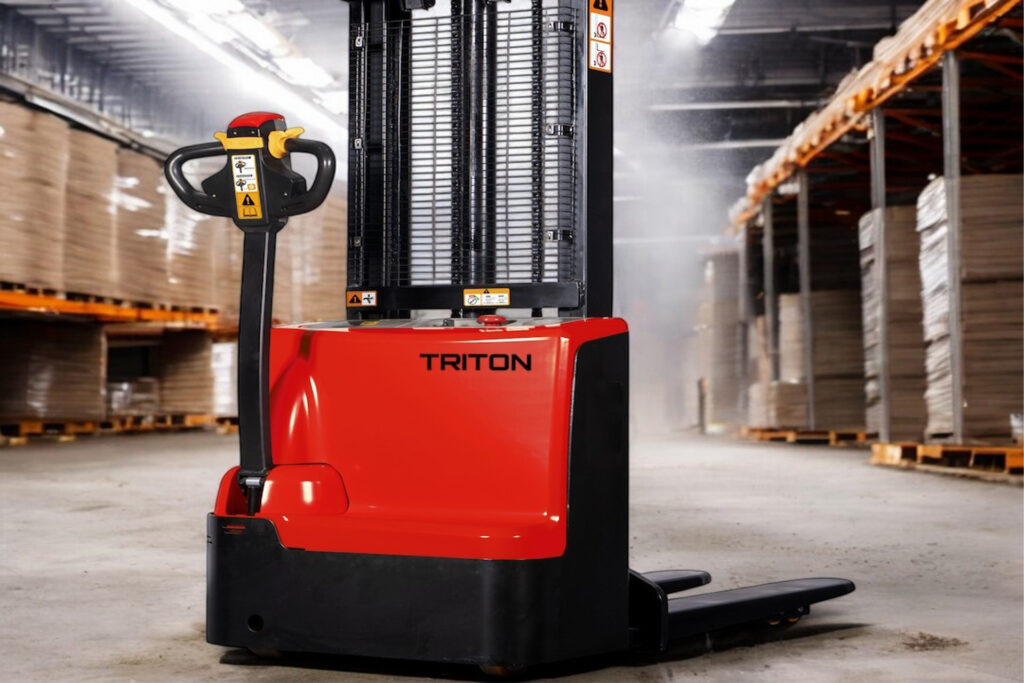
1. Pallet Trucks (Electric + Manual)
Falling into two general categories, or types of pallet trucks, these manual handling aids are either man or electric powered – or sometimes a combination of both. Identifiable by their small physical footprint and low-profile forks, they’re specialised for handling pallets of all sizes, from standard Euro pallets to larger Chep pallets. Either operating via hydraulic pump action or a high-powered Lithium battery and brushless motor combo, the best models out there combine seamless manoeuvrability with a whole host of ergonomic features, including variable drive control, intuitive LCD displays and a comfortable yet strong grip.
- Distinctive features: Compact dimensions, manual or electric operation
- Uses: Transferring pallets from one location to another, such as on-loading or off-loading vehicles or stacking shelves with inventory.
- Class: 3
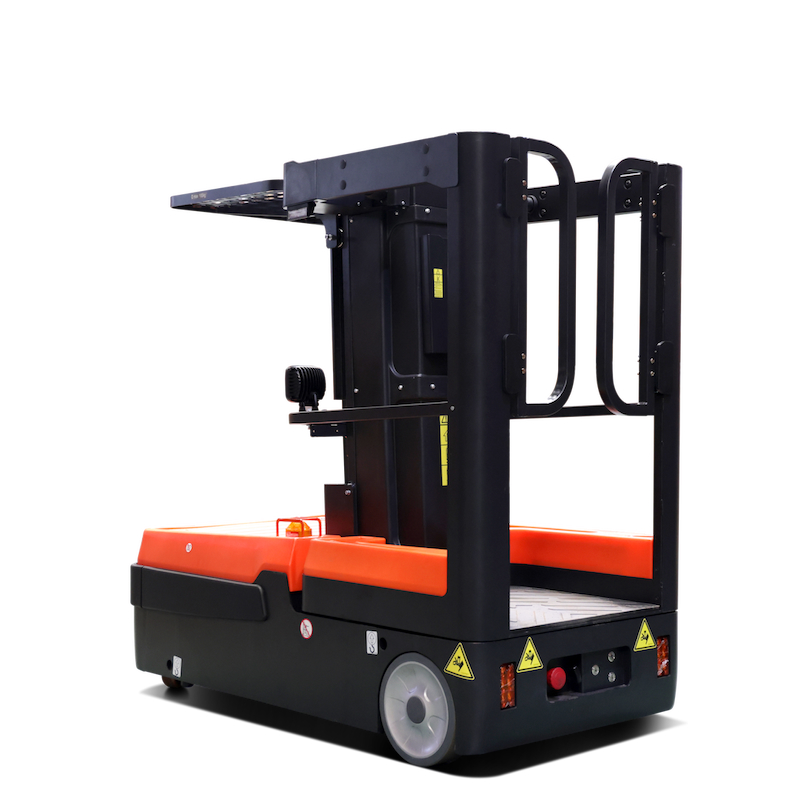
2. Order Pickers
Order pickers, like the EOP3-4.5, allow easy access to moderate heights and are most often found in warehouse environments. Typically, they are used in an inventory context due to their ability to lift individual units to heights of up to 32 feet, making light work of the journey up to warehouse racks. Their versatile design means they’re an excellent choice for moving all sorts of loads from auto parts to furnishings – you name it!
- Distinctive features: Open operator window and a lack of pallet handling features.
- Uses: Piece-picking units and dealing with warehouse inventory at height.
- Class: 2
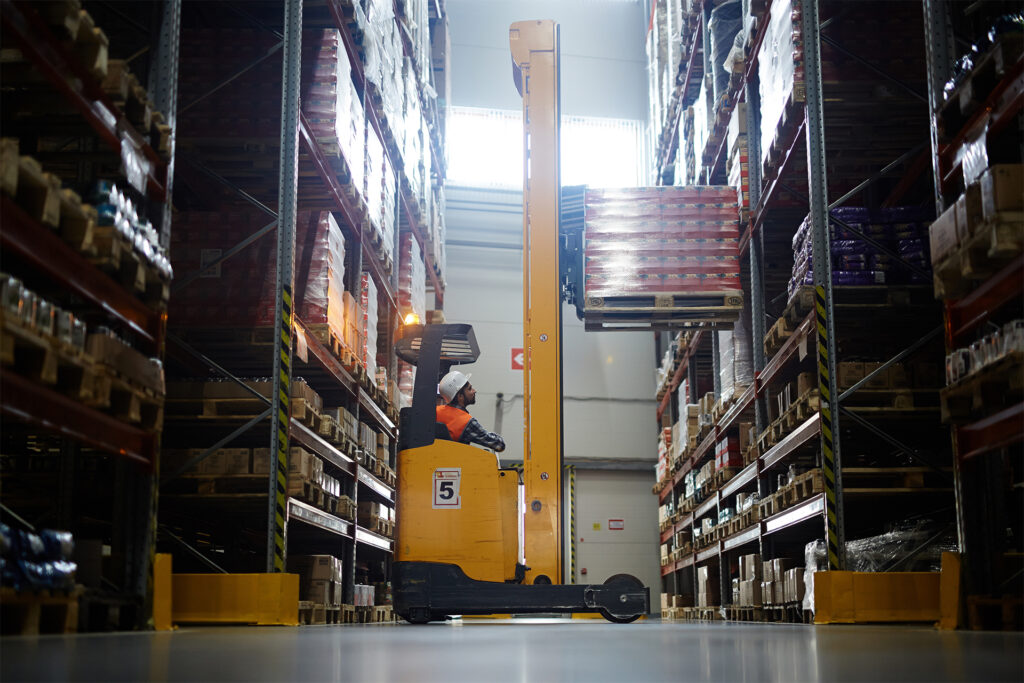
3. Reach Forklifts
Commonly found in warehouse environments, reach forklifts are specially engineered to extend their forks beyond the confines of the machine’s chassis – hence the name. This allows them to reach into racking systems and handle inventory stored at greater depths and heights than a standard counterbalance forklift can manage. Most reach trucks are electric and feature stabilising legs in place of counterweights, enhancing load capacity without sacrificing balance.
- Distinctive features: Extended reach mechanism, stabilising legs, plus an elevated operator seat for improved visibility.
- Uses: Retrieving and placing inventory in high racking systems, especially in warehouses with narrow aisles.
- Class: 2

4. Counterbalance Forklifts
Arguably the most recognisable forklift type, counterbalance forklifts use rear-mounted weights to offset the load weight lifted by the forks at the front. Their straightforward design – with no arms or extending mechanisms – makes them simple to operate and ideal for many general-purpose lifting applications. Available in electric, diesel or LPG variants, they’re a highly versatile option suitable for both indoor and outdoor use.
- Distinctive features: Rear counterweight, no outriggers or arms, and straightforward driving experience.
- Uses: General lifting, stacking and transport of pallets across warehouses, loading bays and factory floors.
- Class: 1 (electric) or 4/5 (internal combustion, depending on tyre type)
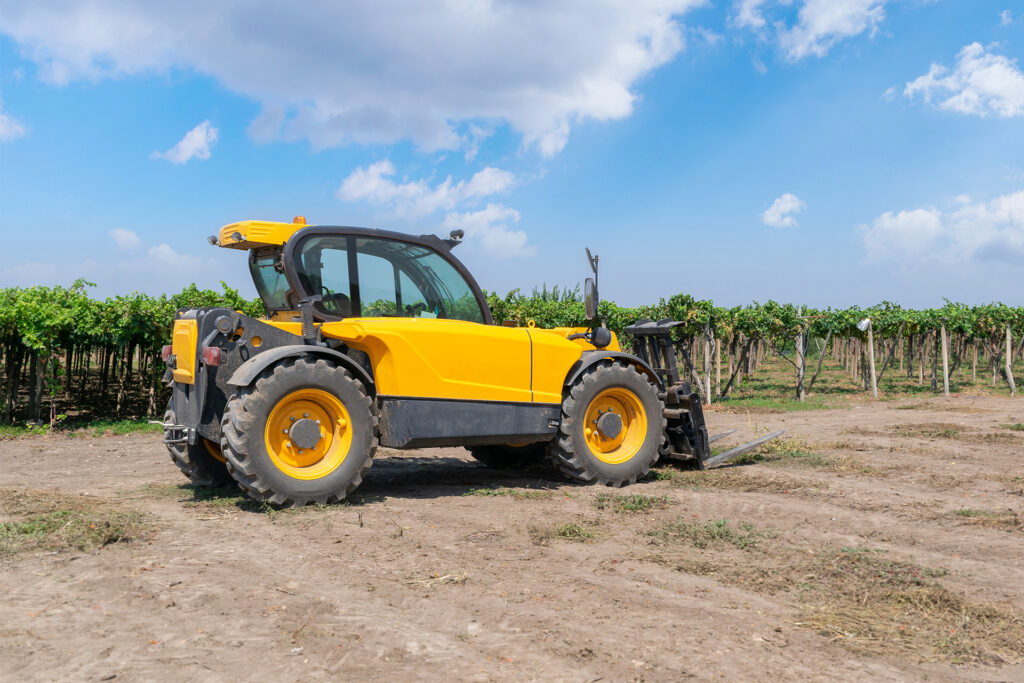
5. Rough Terrain Forklifts
Specifically built to perform on uneven or unstable surfaces, rough terrain forklifts are rugged machines equipped with large pneumatic tires, powerful engines, and enhanced suspension systems. They are a staple across construction sites, lumber yards, and agriculture – anywhere that isn’t paved and predictable. If you need a compromise between these qualities and size, rough terrain pallet trucks are also a good shout.
- Distinctive features: High-clearance chassis, oversized treaded tires, and robust engines.
- Uses: Outdoor lifting and transport tasks on gravel, mud or otherwise uneven terrain.
- Class: 7
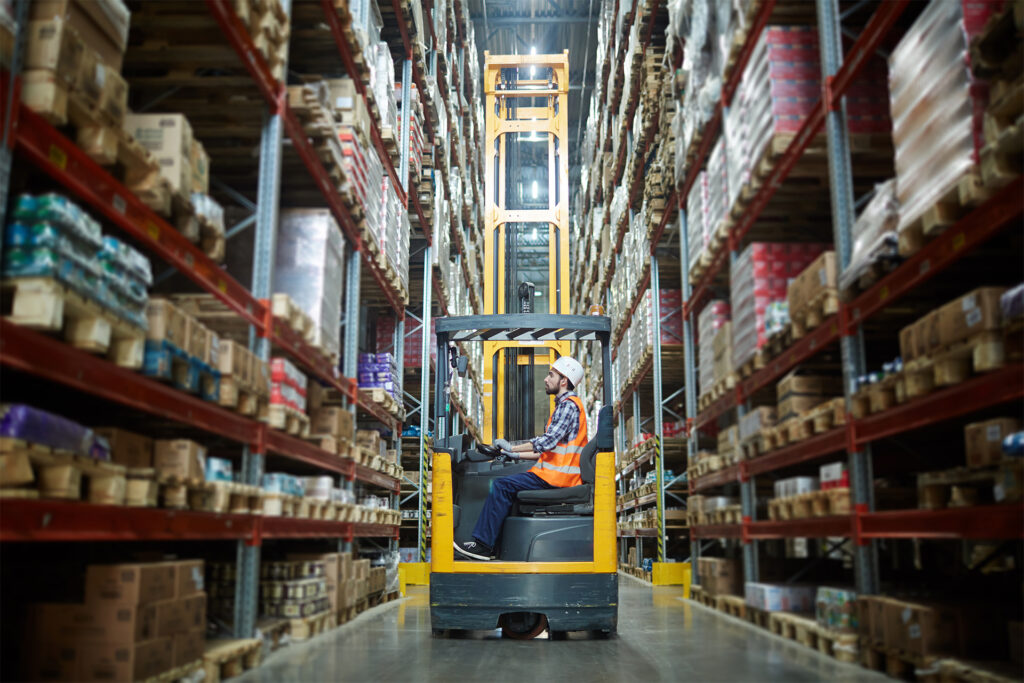
6. Side-Loaders
Unlike traditional forklifts that lift from the front, side-loaders carry loads – you guessed it – on their side, enabling them to navigate narrow aisles with long or bulky items. The operator stands sideways, improving visibility when handling elongated loads like piping, lumber, or steel bars. These are common in timber yards and manufacturing plants with limited space.
- Distinctive features: Side-facing forks and operator cabin, narrow design, ideal for long load handling.
- Uses: Transporting long, awkward loads through narrow aisles or tight warehouse spaces.
- Class: 2
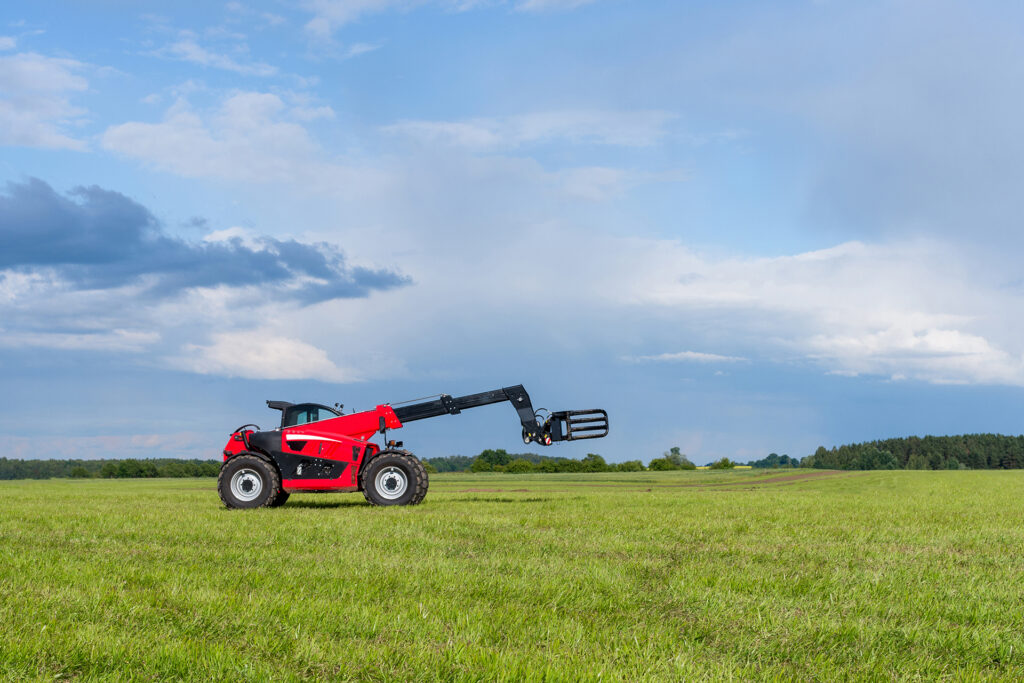
7. Telehandlers
A hybrid between a forklift and a crane, telehandlers (telescopic handlers) feature a boom arm that can extend forwards and upwards. Some models can lift loads over 50 feet, making them ideal for both lifting and placing materials at height. Attachments like buckets, hooks, or work platforms add further versatility. While not classed as a traditional forklift under UK regulations, they are still considered lifting equipment and must comply with LOLER and PUWER standards.
- Distinctive features: Telescopic boom arm, off-road capabilities, and compatibility with a wide range of attachments.
- Uses: Lifting and placing heavy or palletised loads at height across construction, agriculture and industrial sites.
- Class: Not assigned a standard forklift class; typically grouped with rough terrain or heavy-lifting vehicles.
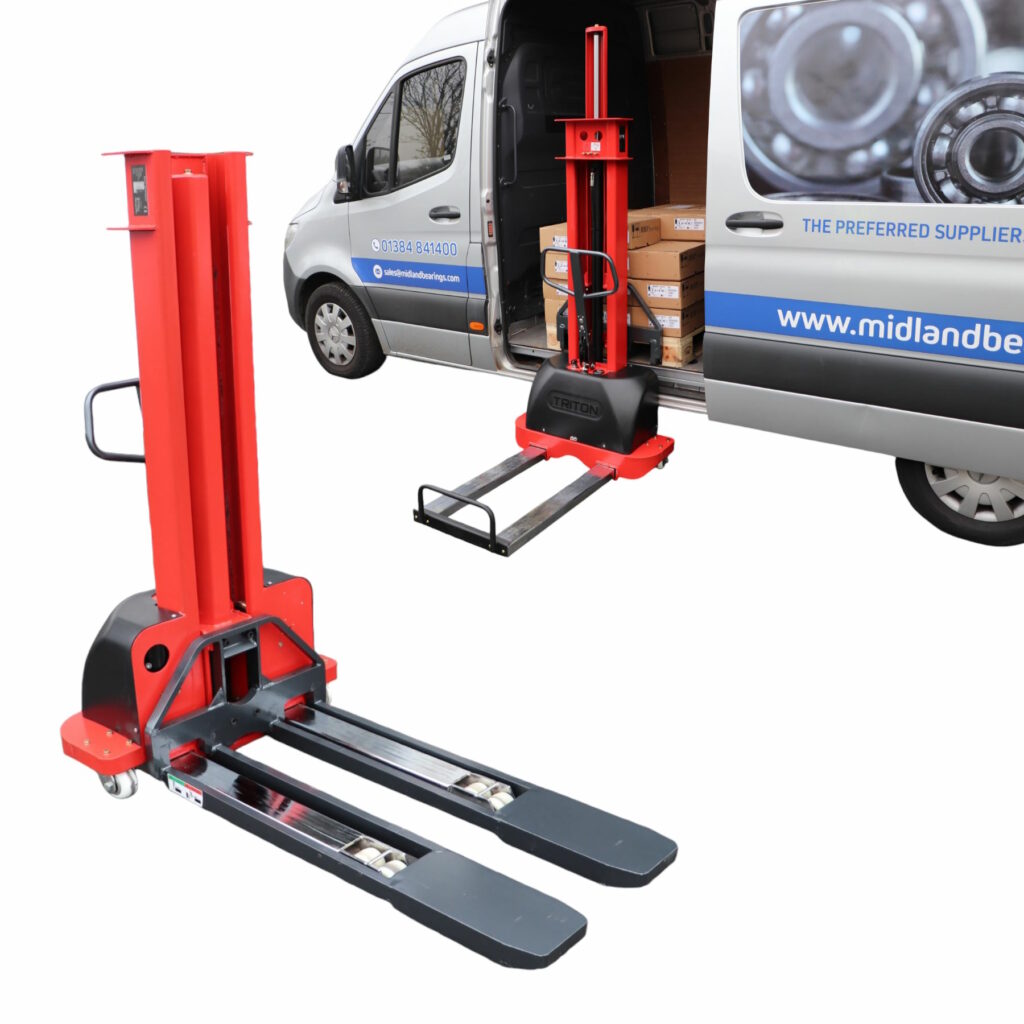
8. Stackers
Ideal for low to mid-height stacking tasks, stackers offer more lift capability than a pallet truck but less than a full-size forklift. Operated either manually or electrically, they are lightweight and compact, making them perfect for confined warehouse areas. Their affordability and ease of use make them a popular choice for smaller operations or as a secondary support truck.
- Distinctive features: Upright mast, walk-behind operation, manual or electric lift function.
- Uses: Stacking pallets at modest heights, often in small warehouses or storage rooms.
- Class: 3
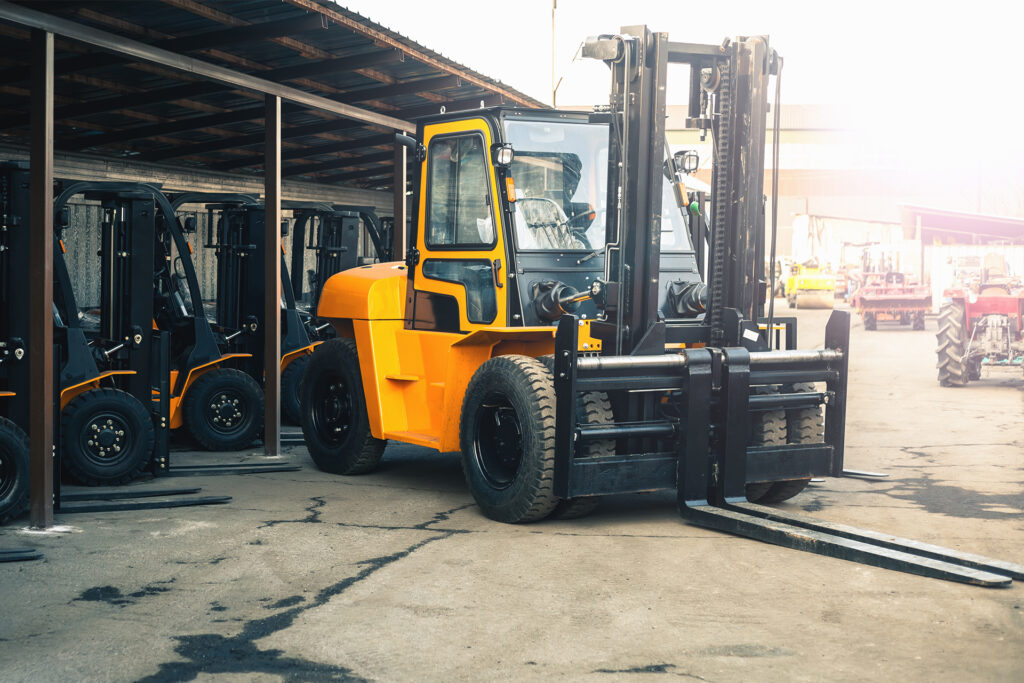
9. Heavy-duty Forklifts
Also known as large-capacity forklifts, these are the powerhouses of the forklift world. Designed to handle exceptionally heavy or oversized loads, they are common in ports, steel yards, and industrial facilities dealing with shipping containers, large machinery, or heavy timber. Their high-lift capacity is complemented by reinforced frames and extra-wide forks. Plus, you can find similar heavy-duty models among pallet trucks.
- Distinctive features: High load capacity (typically over 15,000 kg), reinforced structure, and powerful engines.
- Uses: Transporting ultra-heavy loads such as shipping containers or industrial equipment.
- Class: 5 or 7 (depending on tire and fuel type)

10. Very Narrow Aisle (VNA) Forklifts
Tailored for ultra-tight spaces, VNA forklifts are engineered to navigate warehouse aisles that are often less than six feet wide. They operate on guided rail systems or wire guidance and are usually designed for high rack picking and stacking tasks. With rotating forks or articulating masts, these trucks can handle loads without needing to turn, maximising efficiency in high-density storage facilities.
- Distinctive features: Compact chassis, articulated or rotating forks and guidance systems for tight navigation.
- Uses: High-level stacking and picking in densely packed warehouse environments.
- Class: 2
An Overview Comparison: How Do Different Types of Forklift Trucks Fare Against One Another?
Need a quick side-by-side overview? Use this chart to compare key capabilities across the most common forklift types.
| Forklift Type | Indoor Use | Outdoor Use | Narrow Aisle | High Lift | Heavy Load | Long Load Handling | Electric Option | Manual Option | Maintenance Level |
|---|---|---|---|---|---|---|---|---|---|
| 1. Pallet Trucks | ✅ | ⚠️ (light outdoor only) | ✅ | ❌ | ❌ | ❌ | ✅ | ✅ | Low – few moving parts; basic battery or hydraulic maintenance |
| 2. Order Pickers | ✅ | ❌ | ✅ | ✅ | ❌ | ❌ | ✅ | ❌ | Medium – regular checks on lifts, batteries, safety sensors |
| 3. Reach Forklifts | ✅ | ❌ | ✅ | ✅ | ⚠️ (limited) | ❌ | ✅ | ❌ | High – complex lift system and sensors; narrow aisle demands precision tuning |
| 4. Counterbalance | ✅ | ✅ | ❌ | ⚠️ (mid) | ✅ | ❌ | ✅ / ❌ | ❌ | Medium–High – depends on power type; IC engines need more frequent service |
| 5. Rough Terrain | ❌ | ✅ | ❌ | ⚠️ (mid) | ✅ | ❌ | ❌ | ❌ | High – off-road wear, engine strain, tires require regular inspection |
| 6. Side-Loaders | ✅ | ✅ | ✅ | ⚠️ (mid) | ✅ | ✅ | ✅ | ❌ | High – specialised systems; lateral wear; fewer service providers |
| 7. Telehandler | ⚠️ (limited) | ✅ | ❌ | ✅ | ✅ | ✅ | ❌ | ❌ | Very High – telescopic booms + hydraulics; terrain & lift height = complex service |
| 8. Stackers | ✅ | ⚠️ (light only) | ✅ | ⚠️ (low-mid) | ❌ | ❌ | ✅ | ✅ | Low–Medium – simple electronics or pump; less stress/load than full forklifts |
| 9. Heavy-duty Forklifts | ⚠️ (large spaces only) | ✅ | ❌ | ⚠️ (mid-high) | ✅ | ❌ | ❌ | ❌ | Very High – high engine strain; specialist parts; requires skilled technicians |
| 10. VNA Forklifts | ✅ | ❌ | ✅ | ✅ | ⚠️ (moderate) | ❌ | ✅ | ❌ | High – guidance systems, rotating masts, complex electronics = specialist servicing |
Quickfire Considerations for Choosing the Right Type of Forklifts
Before we wrap things up, allow us to leave you with some guiding considerations that will support you throughout the decision process. By keeping the following factors top-of-mind, it will be much less hassle selecting the correct model for yourself, your site and your colleagues.
Ergonomics & Safety
As with any new equipment or machinery, you should be screening for safety and ease of use. With heavier-duty types of forklifts or those deployed in faster-paced, perhaps more hazardous environments, we can’t emphasise this enough.
While a sobering fact to share, it’s worth bearing in mind that, in the UK, 1,300 people are involved in forklift-related accidents every year – this includes co-workers in the vicinity of the trucks, not just the operator. Thus, on top of the environmental control measures implemented, such as keeping the facility well-lit and well-maintained, managers should consider how prioritising high-quality, compliant equipment can improve safety.
To minimise manual handling hazards in connection with your forklifts, look out for ergonomic features like adjustable seating and armrests, panoramic rear mirrors and intuitive control systems. With visibility and fatigue tackled, operators can enjoy peace of mind knowing the risks are lessened.
Size and Dimensions
Before purchasing a forklift, make sure to check and double-check that the dimensions are compatible with its envisioned application. In warehouses, stock rooms and building sites, you may have to consider opting for a more slimline, class 2 model that can accommodate tight turns, narrow aisles and other restricted areas. If congestion is the norm, you might even want to consider an electric pallet truck as a compromise between size and heft. Conversely, if you need something a bit heavier duty (minus the physical stature), you could always use forklift extensions for a smaller model, given that the truck and forks are compatible.
Weight Bearing Capacity
There is a lot of variance in forklift load capacity between models, so it’s crucial to pore over the specs with a fine-tooth comb. It’s all about ensuring your chosen model can handle the demands of your day-to-day operations and then some, avoiding the possibility of overloading the vehicle. Remember, high weights increase the risk of injury; therefore, both the typical load weight and the maximum capacity need to figure into your decision.
Lifespan & Durability
The frequency and intensity of forklift use in your daily operations remain crucial factors in your evaluation. Heavy-duty forklifts are built to handle demanding, continuous workloads, whereas lighter-duty models may be better suited for occasional or less strenuous tasks. Another point to keep in mind is battery type; after all, it has a direct impact on lifespan and how much wear and tear the truck can tolerate. Most modern forklifts feature rechargeable batteries, of which you can keep a spare in order to keep the equipment in continual use.
Budget
Finally, much like any other major equipment purchase, budget will lay the parameters of your decision. While the lowest-cost option may seem appealing, it’s often more cost-effective in the long run to invest in a high-quality model that aligns with your specific operational needs. A well-built forklift can reduce maintenance expenses and boost productivity over time, whilst lowering the risk of workplace injuries, which in turn helps limit the likelihood of legal issues, possible financial losses and damage to your business’s reputation.
FAQS
How Much Does a Forklift Truck Cost?
A: Prices vary along with forklift type and specs. Manual pallet trucks may start under £300, while heavy-duty forklifts can reach £50,000+. Electric models fall somewhere in between.
Which Type of Forklift is Best?
A: It entirely depends on your use case. For narrow warehouse aisles, reach or VNA forklifts are ideal. For heavy outdoor work, rough terrain or telehandlers are preferred.
How Much Maintenance Do They Require?
The level of maintenance needed varies significantly depending on the type of forklift, its power source, and how and where it’s used:
Low Maintenance: Manual pallet trucks and basic electric stackers need only routine checks like tire wear and battery top-ups.
Medium Maintenance: Electric models (e.g., order pickers, counterbalance forklifts) need battery upkeep and regular inspections of brakes, hydraulics and lift components.
High Maintenance: Machines used in tight or high-demand conditions (e.g., reach trucks, VNA forklifts) require more complex servicing due to their sophisticated guidance systems and narrow operating tolerances.
Very High Maintenance: Rough terrain, telehandlers, and heavy-duty forklifts face intense usage. Their engines, hydraulics, and specialised parts often need expert technicians and more frequent service.
What are the Legal and Training Requirements?
Forklift operators are required by law to complete certified training for each type of forklift they use, with refresher courses recommended every 3-5 years. Employers must ensure that operators are trained, maintain certification records, and follow safety protocols to stay compliant with local regulations.
Over To You
As those responsible for equipping a site, it can be tempting to pick the cheapest option and call it a day. However, with the rise of new forklift advancements and their raw potential for improving workplace productivity, it’s always a more sensible choice to fully explore all of the options available. After all, your decision can directly impact your bottom line.
Ready to take that next step and begin browsing handling equipment? From manual and electric pallet trucks to order pickers, and your extra fork extensions, we have you covered. Still considering? In the meantime, you can explore further industry insights on the rest of our blog.
